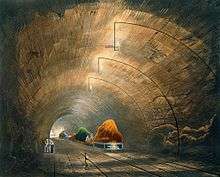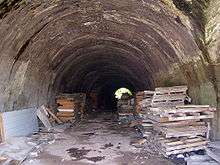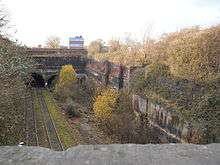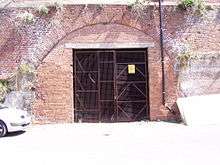Wapping Tunnel


Wapping or Edge Hill Tunnel in Liverpool, England, was constructed to enable goods services to operate between Liverpool docks and Manchester, as part of the planned Liverpool and Manchester Railway. It was the first tunnel in the world to be bored under a city.[1] The tunnel is 2,030 metres (1.26 mi) long, running downhill from the western end of the 262 metres (0.163 mi) long Cavendish cutting at Edge Hill in the east of the city, to Park Lane Goods Station near Wapping Dock. The Edge Hill portal is near the former Crown Street Station goods yard. The tunnel passes beneath the Merseyrail Northern Line tunnel approximately a quarter of a mile south of Liverpool Central underground station.
The original proposal for the railway out of Liverpool ran north along the docks, but this route proved very unpopular with local landowners. The new route required considerable engineering works in addition to the tunnel. The 1 in 48 gradient was much too steep for the steam locomotives of the day. A stationary steam engine was installed at the Cavendish cutting at Edge Hill in a short tunnel bored into the rock face on the side of the cutting, near a Moorish Arch that spanned the cutting. Goods wagons were hauled by rope up from the Park Lane goods station at the south end docks. The goods wagons were hitched to locomotives at the Edge Hill junction for the continuing journey to all location from Liverpool to Manchester. The tunnel opened in 1830 closing on 15 May 1972.
The dockside portal to the tunnel is clearly visible on Kings Dock Street. This was the middle of three short exit tunnels at the western end, which met in a short open ventilation cutting between Park Lane and Upper Frederick Street. The quoted length of 2030m includes both the main tunnel and the short exit tunnel.
The Edge Hill entrance is still open to the atmosphere, however not accessible to the public. The portal is the central of three tunnels at the western end of the Cavendish cutting. The right hand tunnel is the original 1829 tunnel into Crown Street Station. The left hand tunnel is the later 1846 tunnel into the Crown Street goods yard. This tunnel currently has tracks, for use as a headshunt and locomotive run-round for goods trains. However, artwork from before the third tunnel was constructed shows that a portal was already present from the outset - this was purely for architectural symmetry and is, in fact, a store room.
Other visible evidence of the tunnel still exists, in the form of three imposing red-brick ventilation towers. One is on the landscaped park between Crown Street and Smithdown Lane, one on Blackburne Place (illustration), and one close to Grenville Street South. There were at least two others that were later demolished, one adjacent to Great George Street, and one by Myrtle Street.
Recent plans for partial reinstatement of tunnel



In the 1970s, during planning work for the Merseyrail underground in Liverpool city centre, there were two proposals to use parts of the Wapping Tunnel or Waterloo Tunnel (Victoria Tunnel) to connect Liverpool Central and Edge Hill junction. During the construction of the Merseyrail network in the 1970s a part of the tunnel south out of Central Station impinged on the tunnel's roof reducing the height.[2] This would require lowering the floor of the tunnel at this point to allow trains to pass.
In May 2007 it was reported that Merseytravel Chief Executive Neil Scales had prepared a report outlining the possibilities for reuse of the tunnel.[3][4]
In 2011, the car manufacturer Land Rover used the tunnel as part of the press launch route for its Evoque model, with journalists driving through water inside the tunnel. [5]
References
- ↑ "Wapping and Crown Street Tunnels". Engineering Timelines. Retrieved 2016-09-14.
- ↑ "Subterranea Britannica: Sites: Wapping Tunnel". Subbrit.org.uk. Retrieved 2015-09-03.
- ↑ Coligan, Nick (2006-07-17). "The trams are dead, long live the train". icLiverpool. Retrieved 2008-09-10.
- ↑ Nield, Larry (2007-05-30). "Plan to reopen railway tunnels". icLiverpool. Retrieved 2008-09-10.
- ↑ "Range Rover is a Fab Four by Four". Liverpool Echo. Retrieved 2016-09-14.
External links
- Subterranea Britannica: Liverpool - Edge Hill Cutting & Tunnels
- Photo of Blackburne Place shaft at flickr
- Photo of White Street shaft at flickr
- Photo of Crown Street shaft at flickr
- Engineering Timelines
Coordinates: 53°23′59″N 2°58′11″W / 53.39972°N 2.96972°W